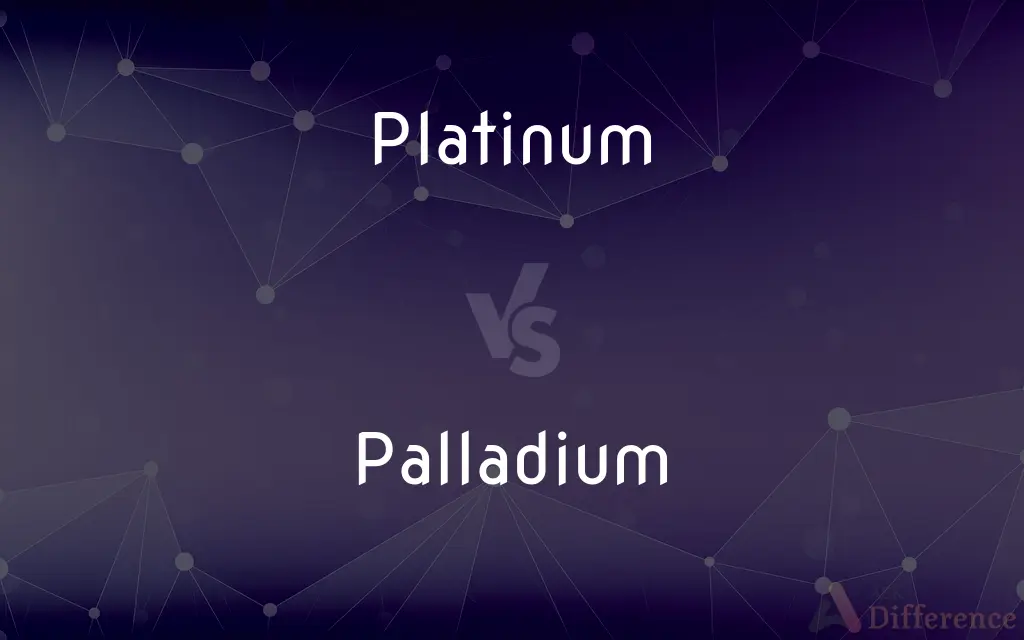Platinum vs. Palladium — What's the Difference?
By Tayyaba Rehman & Fiza Rafique — Updated on May 19, 2024
Platinum is a dense, malleable, precious metal used in jewelry and industry, while palladium is a lighter, more abundant metal often used in electronics and catalytic converters.

Difference Between Platinum and Palladium
Table of Contents
ADVERTISEMENT
Key Differences
Platinum is a dense, malleable metal known for its high resistance to corrosion and tarnish, making it a popular choice in jewelry. Palladium, on the other hand, is lighter and more abundant, commonly used in electronics and automotive catalytic converters due to its excellent catalytic properties.
Platinum's density and weight make it a preferred metal for luxury items and high-end industrial applications, whereas palladium's lower density and higher availability make it more cost-effective for mass production uses.
In terms of appearance, platinum has a silvery-white color that maintains its luster over time, while palladium also has a similar appearance but can develop a slight patina with wear, giving it a more rustic look.
Both metals are used in investment and are traded on global markets, but platinum is generally more expensive per ounce due to its rarity and demand in high-end applications. Palladium's price, however, has seen significant increases due to its rising demand in the automotive industry for pollution control.
Platinum is less reactive and has a higher melting point, making it suitable for high-temperature applications, while palladium is more reactive and has a lower melting point, which limits its use in certain high-heat environments.
ADVERTISEMENT
In jewelry, platinum is often preferred for its hypoallergenic properties, whereas palladium, while also hypoallergenic, is less commonly used but valued for its lighter weight and lower cost.
Comparison Chart
Density
High, very dense and heavy
Lower, lighter weight
Appearance
Silvery-white, maintains luster
Silvery-white, may develop a slight patina
Applications
Jewelry, industrial uses, high-end electronics
Automotive catalytic converters, electronics
Price
Generally more expensive
Less expensive, but prices have risen recently
Reactivity
Less reactive, high melting point
More reactive, lower melting point
Compare with Definitions
Platinum
A metal known for its high resistance to corrosion and tarnish.
Platinum's durability makes it ideal for wedding bands.
Palladium
A key component in automotive catalytic converters.
Palladium helps reduce vehicle emissions.
Platinum
A catalyst in various chemical reactions.
Platinum is crucial in the process of refining oil.
Palladium
A metal that is lighter and more abundant than platinum.
Palladium's lower weight makes it suitable for various applications.
Platinum
A chemical element with the symbol Pt and atomic number 78.
Platinum is often used in laboratory equipment.
Palladium
A lustrous, silvery-white metal used in electronics.
Palladium is essential in the manufacturing of smartphones.
Platinum
Platinum is a chemical element with the symbol Pt and atomic number 78. It is a dense, malleable, ductile, highly unreactive, precious, silverish-white transition metal.
Palladium
A chemical element with the symbol Pd and atomic number 46.
Palladium has excellent catalytic properties.
Platinum
A trademark for a certification indicating that a recording, such as an album of music, has sold a million copies.
Palladium
A precious metal often used as an investment.
The demand for palladium has increased among investors.
Platinum
Symbol Pt A silver-white metallic element occurring in alluvial deposits in sperrylite and nickel ores, usually mixed with other metals such as iridium, osmium, or nickel. It is ductile and malleable, does not oxidize in air, and is used as a catalyst and in electrical components, jewelry, dentistry, and electroplating. Atomic number 78; atomic weight 195.08; melting point 1,768.2°C; boiling point 3,825°C; specific gravity 21.45 (20°C); valence 2, 3, 4. See Periodic Table.
Palladium
Palladium is a chemical element with the symbol Pd and atomic number 46. It is a rare and lustrous silvery-white metal discovered in 1803 by the English chemist William Hyde Wollaston.
Platinum
A medium to light gray.
Palladium
A soft, ductile, lustrous gray-white, tarnish-resistant, metallic element occurring naturally with platinum, especially in gold, nickel, and copper ores. Because it can absorb large amounts of hydrogen, it is used as a purification filter for hydrogen and a catalyst in hydrogenation. It is alloyed for use in electric contacts, jewelry, nonmagnetic watch parts, and surgical instruments. Atomic number 46; atomic weight 106.4; melting point 1,554.8°C; boiling point 2,963°C; specific gravity 12.02 (20°C); valence 2, 3, 4. See Periodic Table.
Platinum
The chemical element with atomic number 78 and symbol Pt; a dense, malleable, ductile, highly unreactive, silverish-white transition metal of great value.
Palladium
A safeguard, especially one viewed as a guarantee of the integrity of social institutions
The Bill of Rights, palladium of American civil liberties.
Platinum
A whitish grey colour, like that of the metal.
Palladium
A sacred object that was believed to have the power to preserve a city or state possessing it.
Platinum
(music) A single or album that has achieved platinum sales, i.e. over 1 million or 2 million.
Palladium
A safeguard.
Platinum
A platinum-based drug: a platin#Etymology 2.
Palladium
A chemical element (symbol Pd) with an atomic number of 46: a rare, lustrous silvery-white metal.
Platinum
Of a whitish grey colour, like that of the metal.
Palladium
(countable) A single atom of this element.
Platinum
Of a musical recording that has sold over one million copies (for singles), or two million (for albums).
Palladium
Any statue of the goddess Pallas; esp., the famous statue on the preservation of which depended the safety of ancient Troy.
Platinum
Very expensive, or of very high quality
We can offer the platinum service for fifty dollars extra.
Palladium
That which affords effectual protection or security; a safeguard; as, the trial by jury is the palladium of our civil rights.
Platinum
(computer games) to reach platinum level in a game
I platinumed in Clash of Clans yesterday.
Palladium
A rare metallic element of the light platinum group, found native, and also alloyed with platinum and gold. It is a silver-white metal resembling platinum, and like it permanent and untarnished in the air, but is more easily fusible, with a melting point of 1555° C. It can also be prepared as a finely divided black powder. It is unique in its power of absorbing hydrogen, which it does to the extent of nearly a thousand volumes, forming the alloy Pd2H. It is used for graduated circles and verniers, for plating certain silver goods, and somewhat in dentistry. It was so named in 1804 by Wollaston from the asteroid Pallas, which was discovered in 1802. Symbol Pd. Atomic number, 46. Atomic weight, 106.42. Density 12.0.
Platinum
A metallic element of atomic number 78, one of the noble metals, classed with silver and gold as a precious metal, occurring native or alloyed with other metals and also as the platinum arsenide (sperrylite). It is a heavy tin-white metal which is ductile and malleable, but very infusible (melting point 1772° C), and characterized by its resistance to strong chemical reagents. It is used for crucibles in laboratory operations, as a catalyst, in jewelry, for stills for sulphuric acid, rarely for coin, and in the form of foil and wire for many purposes. Specific gravity 21.5. Atomic weight 195.1. Symbol Pt. Formerly called platina.
Palladium
A silver-white metallic element of the platinum group that resembles platinum; occurs in some copper and nickel ores; does not tarnish at ordinary temperatures and is used (alloyed with gold) in jewelry
Platinum
A heavy precious metallic element; gray-white and resistant to corroding; occurs in some nickel and copper ores and is also found native in some deposits
Platinum
A dense, malleable precious metal used in fine jewelry.
The platinum ring sparkled in the sunlight.
Platinum
A valuable commodity often traded in financial markets.
Investors are buying platinum as a hedge against inflation.
Common Curiosities
What is platinum?
Platinum is a dense, malleable, precious metal used in jewelry and industry.
Which is heavier, platinum or palladium?
Platinum is heavier and denser than palladium.
Which metal is more expensive?
Platinum is generally more expensive than palladium.
What is palladium?
Palladium is a lighter, more abundant metal used in electronics and automotive catalytic converters.
Which metal has a higher melting point?
Platinum has a higher melting point than palladium.
Are both metals used in jewelry?
Yes, both platinum and palladium are used in jewelry, though platinum is more common.
Is platinum or palladium more reactive?
Palladium is more reactive than platinum.
Can both metals be used in catalytic converters?
Yes, but palladium is more commonly used in catalytic converters.
Is platinum used in investments?
Yes, platinum is often used as an investment metal.
Do both metals maintain their appearance over time?
Platinum maintains its luster, while palladium can develop a patina.
What are the main uses of platinum?
Jewelry, industrial applications, and high-end electronics.
Which metal is more abundant?
Palladium is more abundant than platinum.
What are the main uses of palladium?
Automotive catalytic converters and electronics.
Is palladium used in investments?
Yes, palladium is also used as an investment metal.
Are both metals hypoallergenic?
Yes, both metals are hypoallergenic.
Share Your Discovery

Previous Comparison
Cane vs. Switch
Next Comparison
Principle vs. PolicyAuthor Spotlight
Written by
Tayyaba RehmanTayyaba Rehman is a distinguished writer, currently serving as a primary contributor to askdifference.com. As a researcher in semantics and etymology, Tayyaba's passion for the complexity of languages and their distinctions has found a perfect home on the platform. Tayyaba delves into the intricacies of language, distinguishing between commonly confused words and phrases, thereby providing clarity for readers worldwide.
Co-written by
Fiza RafiqueFiza Rafique is a skilled content writer at AskDifference.com, where she meticulously refines and enhances written pieces. Drawing from her vast editorial expertise, Fiza ensures clarity, accuracy, and precision in every article. Passionate about language, she continually seeks to elevate the quality of content for readers worldwide.













































